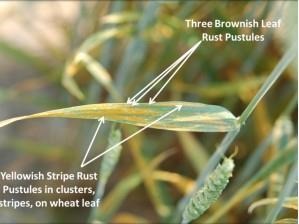By Pierce Paul & Jorge David Salgado

Wheat is now flowering in parts of northern Ohio and will continue to flower over the next weeks of so. According to the FHB forecasting system (http://www.wheatscab.psu.edu/), the risk for scab is low in central and northern Ohio for fields flowering at this time. Although it has rained over the last 2-4 days in parts of the flowering regions, conditions were relatively cool and dry last week, which likely reduced the risk of the scab fungus infecting the wheat spikes. Remember, the scab tool uses average relative humidity during the 15 days immediately before flowering to assess the risk of scab. If 11-13 days during that 15-day window are cool and dry, then the overall risk will likely be low, even if it is wet and humid on the other 2-4 days. Continue to keep your eyes on the weather and the forecasting system over the next week. Fields flowering at the end of this week or early next week (May 26-30) may still be at risk for scab. Prosaro and Caramba are the two fungicides recommended for head scab control. Stay away from the strobilurins when the risk for scab is high as they have been linked to higher grain contamination with vomitoxin. Click on the links below to see updated factsheet # PLPATH-CER-06 for more on head scab of wheat and barley and factsheet # PLPATH-CER-03 for guidelines on how to use and interpret the scab forecasting system.
http://ohioline.osu.edu/factsheet/plpath-cer-06
While we may not have a problem with scab this year, some foliar diseases have increased over the last week or so. In particular, strip rust and Septoria are now showing up and spreading. Both of these develop best under cool, wet conditions, similar to what we have experienced over the last two weeks. Strip rust is not as widespread this year as it was last year. It is localized and restricted to a few varieties, but given the current weather conditions, it could spread rapidly and still affect grain yield and test weight in those varieties. Cool, wet conditions often result in extended grain-fill and higher yields, but this also allows more time for late-season diseases to develop. Scout flowering fields to see if your variety is susceptible to stripe rust, Septoria, or even Stagonospora. Prosaro and Caramba will also provide excellent control of these diseases, but keep your eyes on the pre-harvest intervals – it is 30 days for both. This is probably your last shot as we will likely begin cutting wheat in about 30-40 days in northern Ohio and sooner in the south. It is likely too late to treat fields that are well into grain-fill. Read more on wheat rusts as:
http://ohioline.osu.edu/factsheet/plpath-cer-12.